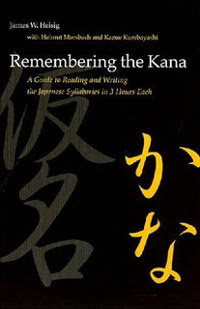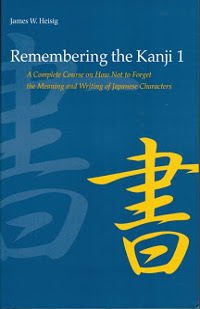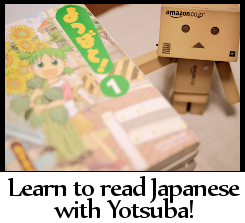Hiragana, Katakana, and Kanji:
About the Japanese Writing System:
The writing system for Japanese is very different from that of English. In English there is a single alphabet, consisting of 26 letters with two forms (upper/lower case). Every English word is written and expressed using these letters, so from a native English speaker's perspective that is just how language works – you use a relatively small pool of characters in different combinations to make new words. I bring this up here because in order to learn Japanese to any real degree, you have to abandon this way of thinking.
In Japanese there are two “alphabets,” which are called the kana. They aren't really the same as our alphabet, because all of the symbols represent a consonant+vowel or just a vowel, but it's essentially the same idea. And where English has one alphabet with two forms for each letter (upper and lower case), Japanese has hiragana and katakana as the two types of kana. Both hiragana and katakana have 46 basic symbols which are used to write out word pronunciations.
You may be surprised that despite having a larger alphabet (46 characters as opposed to our 26), Japanese actually has a big problem with homophones. There isn't much room for sound combinations to create unique words in Japanese, so you get a lot of words with the same pronunciation, but drastically different meanings. So how do you know which meaning a person is trying to convey by looking at kana? Well, you can't really. That's where kanji come in.
Kanji are what really make Japanese. They give meaning to the sounds and the kana, which would otherwise be somewhat ambiguous. This is the concept that native English speakers should really grasp before approaching Japanese, is that learning the kanji isn't optional: it's essential to understanding the language. And as if it wasn't bad enough to hear that the kana consist of nearly 100 characters that must be learned, the common use kanji number at over 2000 total. Two thousand. Definitely a daunting number to look at.
But once again, I think many native English speakers misunderstand what it means to learn the common-use kanji. To an English speaker the only thing similar to kanji is our own alphabet, so it's almost inevitable that “2000 kanji” translates into “an alphabet with over 2000 symbols,” but that's not the case. Kanji are more like words than letters, and by knowing kanji you will be able to understand a lot of words intuitively and learn vocabulary much faster.
You may be wondering about romaji, which is the writing of Japanese using the English alphabet. To put it bluntly, you should never do this. Ever. You will never find any real Japanese text written in this way and you'd really only be wasting your own time to bother studying with it.
⇧ Return to Top ⇧
Learning the Kana:
As mentioned in the introduction above, there are two different sets of kana: the hiragana and the katakana. Hiragana is the more important of the two, as it is used in writing out Japanese words and for grammar functions. Katakana is used almost exclusively for writing foreign words in Japanese. The two are fairly easy to distinguish, as hiragana is very curvy in form, while katakana has a sharp and angular feel.
| Hiragana: | Japanese words, grammar | Curvy shapes | あ, か |
| Katakana: | Foreign words | Angular shapes | ア, カ |
For those who are just beginning to learn Japanese, I recommend starting with the hiragana and leaving the katakana for a later date. The learning process for the two is the same. The easiest way is to simply use flash cards of some kind (refer to the learning tools page for a flash card program and hiragana/katakana decks).
Start with a group of 10 kana and practice writing the Japanese symbol a few times while sounding it out. Once you've written out each kana about five times, go through the flash cards and write your answers down. So if you looked at a card and it said “a,” you would write down “あ.” Or vice versa. It's best to do the cards in both directions. Once you have those ten down, add five new cards in and repeat the process (reviewing all of the cards after learning the new).
For help writing the kana, check out the Yoshida Institute's page.
Click on a kana to get a pop-up of the stroke order.
Now I have to admit something: when I said there were 46 symbols in each of the kana types, I left out a small detail. Well, maybe not so small. Many of those symbols can be modified to change their sound. For instance the hiragana for “ha” is は. But when two small marks are added, to look like this ば, it changes to “ba.” And if a small circle is added instead, like this ぱ, it changes to “pa.” Luckily, this part is fairly easy to remember, and can be summarized in a table like this:
| Add " | Add ° | |
| "K" Sounds: | G | -- |
| "H" Sounds: | B | P |
| "T" Sounds: | D | -- |
| "S" Sounds: | Z | -- |
Some sounds can also be paired to create an intermediate sound. For instance, “ki” (き) and “ya” (や) come together to make “kya” (きゃ). Notice that the second kana, which starts with a “y” sound, shrinks down a bit. There are many different forms this can take, so it's best to just learn the combinations using flash cards.
I am not a big fan of rote memorization, but the kana are so basic in their form that there isn't much else that can be done. However, if you're having a hard time memorizing the kana this way, there is another method. The author of the book which explains how to learn kanji using mnemonic devices (which will be covered in detail later), also wrote a book for the kana. It will give you some experience with the mnemonic learning style and should be the trick to memorizing the hiragana/katakana for good. The book title is:

Remembering the Kana by James W. Heisig.
As the book cover says, the kana can be learned in almost no time at all. Of course, you will need to review, or else you'll forget them as quickly as you learned them. I again recommend using a simple flash card program (see this page for more info) to keep on track with reviewing. It only takes a few minutes a day to stay on top of the kana.
To recap on the kana...
The kana consist of the hiragana and the katakana. For those who are just beginning to learn Japanese, hiragana should be the first thing learned and the katakana should not be learned at the same time. After learning the hiragana, which should take 2-3 days at most, continue to review daily using flash cards. After 2-3 weeks of reviewing, learn the katakana and then add them to your review schedule. The two should be spaced out a bit just to help avoid any confusion as to which symbols go to which set of kana.
⇧ Return to Top ⇧
Learning the Kanji:
This is the most daunting step of the Japanese learning process. Learning kanji is really where success is determined, because once you're through the kanji it's all downhill. The trick with kanji is to not even attempt brute-force memorization methods. I can think of no faster way to get burnt out on learning Japanese than to sit down and try to cram a bunch of kanji into your long-term memory. It's for this reason that I chose to learn kanji entirely separate from vocabulary using mnemonic devices.
So as you may recall from the kana section, the books used for the mnemonic learning style were written by James W. Heisig. We will use another of his books for the kanji portion of our grand Japanese adventure, and it once again has an extraordinarily long sub-title:

Remembering the Kanji by James W. Heisig
This book is what the entirety of our kanji studies will be based on, so I highly recommend that you get a copy of it. If you can't afford it, you can probably get by with just using the review site (kanji.koohii.com) and the free sample chapters.
Overview of the Heisig Method:
So before getting into the gritty details of how to learn the kanji, it's best if we first go over the core principles behind the Remembering the Kanji book and how its author, James Heisig, intended for it to be used. The basic idea is that each kanji is built up from a set of elements, and by learning and naming these elements, we can make mnemonic device stories which will aid in memorizing the writing and meaning of the various kanji. So with the exception of the earliest kanji (which are the most basic and easy to remember), there is almost no brute-force memorization whatsoever. Each kanji is given a key word which relates to its meaning and can be used in the mnemonic story.
For an example of how this works, let's look at the kanji whose key word is “risk.” The kanji is 冒. At this point in the book we would have already learned the two elements that make up the kanji: sun (日) and eye (目). So how would you make a mnemonic based on the elements involved and including the key word? Like this:
If you look up at the sun then you will risk burning your eyes.
In this story we have several things: most importantly we represent all of the elements (sun and eye), and we all include the key word (risk). From that alone we can probably remember what the kanji looks like, but just in case, there is another hint: up. So if we remembered the elements for sun and eye, but couldn't remember how they went together, the up would hint that sun goes above eye. The process of making stories will feel a bit weird at first, but it goes quite fast once you get the hang of it.
For another example we have the kanji for “bright.” 明 is again made up of two elements. You may recognize sun (日), and this time we have moon (月) as well. So for our story this time, draw on whatever you want and make a story (or borrow one from someone else).
Two bright lights keep watch over the planet –
the sun by day and the moon by night.
So once again we have mentioned the two elements (sun and moon) and the key word (bright) in the story. Sun also comes first in the story, so it would make sense to write it first (on the left), and then the moon element on the right.
So that is the main idea behind the Heisig learning process. Take the elements from a kanji and tie them together in a story so that you can remember the key word and how to write it. In this process the most important part is the story, so while it may seem silly, it's definitely something to take seriously.
The Details of Learning the Kanji:
The first and most important element of learning the kanji (and of learning Japanese altogether) is to study every single day. The number of kanji you learn per day isn't all that important, as long as you continue to learn some new kanji each day and review what you already know. I highly advise that you wake up a bit early each day and put in some time to studying the kanji first thing, that way you're certain to have it done. Okay, enough of that, on to the actual how to learn bit.
So you have the Heisig book. At this point I recommend that you read through the introduction of the book. The author explains a lot about the idea behind this learning method and how it all works, as well as offering some good advice for getting the most out of your study time. After that, it's time to jump straight into the first lessons.
With each new kanji you need a story. Heisig provides stories for the first few lessons, so you won't have to do much work here (and there is a resource to help you get shared stories for later lessons, I'll introduce it farther down). Once you have the story, which includes elements, the key word, and hints as to how to write the kanji, recite that story as you write out the kanji. Write each kanji (while reciting the story) about five times, and then move to the next one. Repeat the process. It's important that you both write and recite – it cements the story and connects it to the kanji.
As I said before, it doesn't really matter how many kanji you do at one time, but once you finish the learning process (making the story, reciting, writing) it's time to begin the reviews. That is where our best friend comes in: Reviewing the Kanji. While you could use a flash card program on your computer to do your reviews, this website is really the best resource for the Remembering the Kanji books. This site uses a “smart” flash card system to help you focus on the kanji you don't know as well and also allows you to use stories that others have written for your mnemonics.
Note: The reviewing the Kanji website also has
a sample chapter of Heisig on the front page.
Continuing on, once you have an account on the site you can use the Study function to go through new cards and set stories for them. Once you finish learning you can then add them to your review card pile. For reviewing you will be presented with a card that contains a key word. From that key word you need to remember the story – the story is the key! - and then use the story to write the kanji by remembering the elements. So the process goes like this:
Key Word => Story => Elements => Kanji
After writing the kanji, you “flip” the card and then select if you go the right answer or not. If you did not get the right answer, you will see the card again. If you did get the right answer, you will see the card less often.
For the review process, I advise that you keep on top of those cards. Get through them every single day. If you miss a day, you will find that a ton of cards have built up when you return, so it really is important to keep going.
I've said several times that the number of kanji per day does not matter as long as you keep going, and while that is most certainly true, you should consider how long you want the process to take and set a goal. A lot of people set a goal of 3 months for completing the book. That translates to about 25 new kanji per day. It's definitely possible to achieve this each day; you just need to prioritize studying the kanji and not make excuses.
Consider how long you want the total process to take, and then set a daily goal for new kanji. Try to stick to that number per day. Aim to be consistent; as long as you show up every day, you will eventually reach the end. Don't sweat it if you fall short sometimes, just aim for it again the next day.
Summary of How to Learn the Kanji:
The first step to learning kanji is to make your story and practice writing the kanji as you recite the story. After learning however many kanji, you then need to add them to your reviews (flash cards) and begin to go through them. Look at the keyword, recall the story, write the kanji, and then flip the card and check.
Don't forget to learn new kanji and review old kanji every day!

